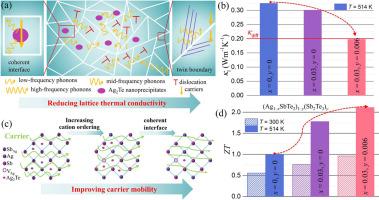通过逐步优化策略减少阳离子无序和合理设计Ag2Te形成,以实现AgSbTe2的高热电性能
IF 14.3
1区 材料科学
Q1 MATERIALS SCIENCE, MULTIDISCIPLINARY
引用次数: 0
摘要
基于agsbte2的材料由于其特殊的热电性能最近获得了极大的关注;但其固有的阳离子无序性和二次相导致其导电性较差。在这项研究中,我们证明了在AgSbTe2中引入Ag空位和Sb2Te3会产生协同效应:i)增强声子散射,有助于在514 K时超低晶格热导率为~ 0.19 W m−1 K−1;ii)降低了载流子散射,导致在513 K时载流子迁移率高达~ 692.20 cm2 V−1 s−1,在514 K时功率因数高达~ 18.2 μW cm−1 K−2;iii)提高了Ag2Te次级相的溶解度,从而提高了AgSbTe2的相稳定性。结果,(Ag0.97SbTe2)0.994(Sb2Te3)0.006样品在514 K时达到了~ 2.1的峰值价值值,在300-514 K的温度范围内达到了令人印象深刻的平均价值值~ 1.47。这项工作为高性能低温热电发电材料的设计提供了一种渐进式的策略。本文章由计算机程序翻译,如有差异,请以英文原文为准。

Reduced cation disorder and rational design of Ag2Te formation via stepwise optimization strategy to achieve high thermoelectric performance in AgSbTe2
AgSbTe2-based materials have recently garnered significant attention due to their exceptional thermoelectric properties; however, their inherent cation disorder and secondary phase result in poor electrical conductivity. In this study, we demonstrate that introducing Ag vacancies and Sb2Te3 into AgSbTe2 induces synergistic effects: i) enhanced phonon scattering, contributing to an ultralow lattice thermal conductivity of ∼0.19 W m−1 K−1 at 514 K; ii) reduced carrier scattering, leading to a high carrier mobility of ∼692.20 cm2 V−1 s−1 at 513 K and a high power factor of ∼18.2 μW cm−1 K−2 at 514 K; iii) improved solubility of the Ag2Te secondary phase, resulting in enhanced of phase stability AgSbTe2. As a result, the (Ag0.97SbTe2)0.994(Sb2Te3)0.006 sample achieves a peak figure-of-merit of ∼2.1 at 514 K and an impressive average figure-of-merit of ∼1.47 over the temperature range of 300-514 K. This work provides a progressive design strategy for high-performance low-temperature thermoelectric power generation materials.
求助全文
通过发布文献求助,成功后即可免费获取论文全文。
去求助
来源期刊

Journal of Materials Science & Technology
工程技术-材料科学:综合
CiteScore
20.00
自引率
11.00%
发文量
995
审稿时长
13 days
期刊介绍:
Journal of Materials Science & Technology strives to promote global collaboration in the field of materials science and technology. It primarily publishes original research papers, invited review articles, letters, research notes, and summaries of scientific achievements. The journal covers a wide range of materials science and technology topics, including metallic materials, inorganic nonmetallic materials, and composite materials.
 求助内容:
求助内容: 应助结果提醒方式:
应助结果提醒方式:


